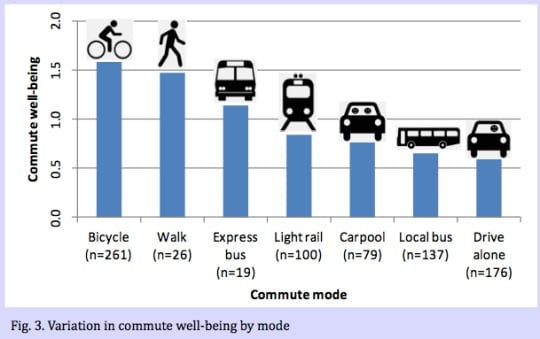
There’s a quiet revolution going on in the field of transportation research. A new guard of young students and up-and-coming professionals are infusing new life and ideas into a body of work that has long been dominated by auto-centric research. They’re the people we’re turning to more and more to answer important questions like; Do bike boxes work? How much auto exhaust do people breathe while bicycling? How does our mode of travel impact spending patterns? And so on.
Portland State University’s urban planning school and the Oregon Transportation Research and Education Consortium (which funds much of the research) is at the forefront of this burgeoning field of study.
Many PSU planning students completed their pilgrimage to the annual meeting of the Transportation Research Board (TRB) which wrapped up last week in Washington D.C.. At an event dubbed ‘TRB Aftershock,’ held last night during happy at a brewpub in northwest Portland, members of PSU’s Students in Transportation Engineering and Planning Club presented their TRB papers for those of us who couldn’t make it to D.C.
When I showed up to the event, the first conversation I had was about a debate over whether the standard and accepted walking speed should be calculated at 3.5 feet per second (which is used now) to a lower speed that favors more humane road design and signal timing. I knew I was in for an interesting night.
Then I met Oliver Smith, a Ph.D. Candidate in Urban Studies at the Nohad A. Toulan School of Urban Studies and Planning at PSU. Smith recently completed a research project titled, Commute Well-being Among Bicycle, Transit, and Car Users in Portland, Oregon (PDF of presentation poster) Based on surveys from 828 people taken during January through February of 2012, he found that commuting to work under your own power “increases commute well-being.” In other words, the happiest commuters are those who walk and bike. Of course I was happy to see that of all modes surveyed, biking made people the happiest (see chart). The lowest measures of commute well-being were recorded by people who drove alone (which is unfortunate because 58% of Portland commuters get to work that way).

Smith’s research also found that people who make over $75,000 per year, and people who are happy with their job and housing situation were more likely to report a high commute well-being. Major factors that dragged down well-being scores included traffic congestion (non-existent for bike riders), crowded transit vehicles, safety concerns (especially for bikers), and travel times longer than 40 minutes (for auto drivers only).
Another bit of research that caught my eye was titled, Modeling Children’s Independent Walk and Bike Travel to Parks and School (PDF of presentation poster) by PSU Ph.D. candidate Joseph Broach and professor Jennifer Dill. The goal was to better understand why fewer kids are walking and biking without their parents these days.
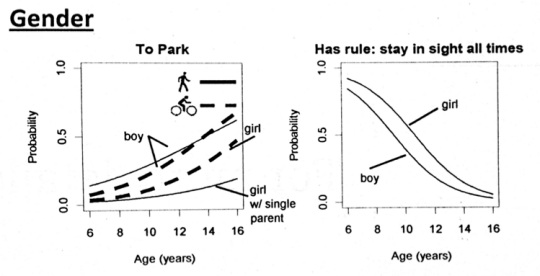
Children aged 6-16 and parents from 323 Portland households were asked questions about travel behavior, perceptions of their neighborhood, perceived social norms, socio-demographics, and so on. Broach and Dill found that, when it comes to kids going it alone in the neighborhood, proximity matters, especially for travel to parks. The average child was nearly three times as likely to walk or bike to a park that is 1/4 mile away from home than one 3/4 a mile away. The practical implication of this, said Broach, is that, “Pocket parks are a big deal.” Pocket parks, like the one created recently on NE Holman Street, are small, neighborhood parks usually built into an existing streetscape.
Gender also played a role in Broach’s research. He found that girls are disciplined with “stay in sight” rules by their parents for an average of 1.5 years longer than boys. Girls were also less likely to travel to parks without their parents (there was no gender difference in school travel rates).
As you might expect, peer pressure also impact biking behaviors among 11-16 year olds. The research found that as children aged, there was a higher probability that wearing a helmet was a barrier to riding. Kids were more likely to bike to school and the park when members of their peer group did so as well.
These papers offer insights that often promote, validate, or refute existing policies. They also influence what types of infrastructure we build. Learn more about transportation research being done here in Portland by visiting OTREC’s website.


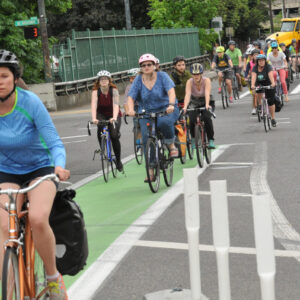
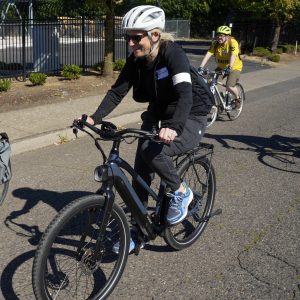
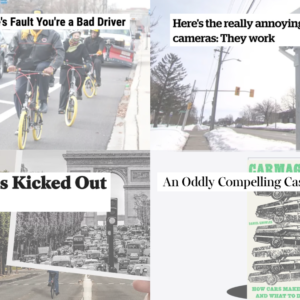
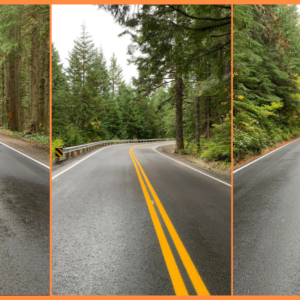
Thanks for reading.
BikePortland has served this community with independent community journalism since 2005. We rely on subscriptions from readers like you to survive. Your financial support is vital in keeping this valuable resource alive and well.
Please subscribe today to strengthen and expand our work.
Eh, careful there, Jonathan, calling congestion non-existent for bike commuters: Lane-splitting is illegal in Oregon, and I can think of a few places in my Southeast-to Marquam Hill commute where that would be the only option for evading congestion.
Lane-splitting is illegal in Oregon
ORS 814.400 “Application of vehicle laws to bicycles” says bicycles are “(1) subject to the provisions [of] any other vehicle…except: (b) When otherwise specifically provided under the vehicle code.” 814.240 “Motorcycle or moped unlawful passing” specifically provides that motorcycles and mopeds are prohibited from land-splitting but doesn’t mention bicycles or vehicles, so exception (b) applies. IANAL, that’s just my interpretation and maybe there is further case law clarifying it, but that’s how it looks to me. I’m not advocating that lane-splitting is wise or cautious or otherwise advisable (I don’t think it is, in general), or that a cop might not try to cite a bicyclist for it, but if you think it is prohibited, could you cite the statute or case law?
Nope Alan, no case law that I’m aware of. My reasoning is just that if I’m on a two-wheeler and I have the speed and power to pass four-wheeler traffic, it’s only wonkishly relevant whether I have a motor or not. The same risks and concerns exist around attempting to make a lane where none exists.
I guess maybe you could get away with it, letter vs. spirit, in a court of law–but is anyone’s interest really served over the long term by riding like an a-hole?
…and in a redemptive attempt to merge back into the topic, what would be the effect of such behavior on commuters’ happiness–both the splitters and the splitees?
Ack to the “on topic,” and I’ll try to get there, too.
The claim of “illegal” grates on me because (1) bike riders as a group are already way too widely accused of illegal behaviour, so I see no reason to add more false charges, and (2) as it’s the premise of your statement, its falseness detracts from your conclusion, yet I have at least some agreement with your conclusion, so I need to reexamine the premise.
BTW, there’s a thread in the forums about a somewhat related case, where RonC was cited for how he made a left turn: filtered up to the front of left-turning cars at a light, essentially splitting between the left-turn and straight lanes. The cop didn’t show up in court so Ron won by default.
As to the combined gross happiness of drivers and riders, that’s outside the scope of this study of individual happiness. Gross happiness doesn’t need to be a zero-sum static value, but at the same time it’s unlikely, even unreasonable, to expect both groups to act in manners intended to maximize that value. Each individual is going to maximize his or her own happiness. Very few, if any, will say to themselves, “I’d be happier if I did X, and it’s really not hurting anything or illegal, but it might make some other people unhappy so I won’t do it.” Bike riders filtering forward at a stop light, or moving between lanes through gummed up traffic, will probably feel happier about moving along than if they were stuck in the cars. That seems understandable and rational. It increases both individual happiness and gross happiness. Some car occupants may feel jealous or otherwise upset about bikes moving through (and others probably won’t feel that way, just neutrally observe the bike pass by) but it really isn’t costing them anything, so it’s not rational to feel antagonized, but it happens to some people. Whether it happens enough to balance or outweigh the bike riders’ gross happiness, I couldn’t say. But if all the stars are lined up so that my happiness–including my evaluation of safety, legality and other concerning factors, maybe even including gross happiness of all around me–will increase, I might just split lanes.
See, we differ there, Alan. My spidey-sense tingles when I’m tempted to “filter up” between occupied lanes; it increases my risk for no good reason (I’m not on my way to extinguish a fire or save a life); it *erodes* my happiness. But give me a clear lane and I have no moral or physical problem passing. And I contend that what you mentioned—people electing not to take some option out of concern for others’ happiness (as well as for the *spirit* of the law) is exactly what the world needs, in spades. “Be the change you want to see in the world.”
door, hook, and vehicle emissions risk sometimes out weigh any concern i have for the theoretical emotional response of motorists.
to be specific: despite the ghost bike i still see people carelessly cycling into the potential right hook at madison and 3rd all the time. as a form of protest, i now always enter that bike box from the lane or by filtering between motionless cars. i do this because i am trying to “be the change [I] want to see in the world.” if cyclists were more aggressive about asserting their rights and less concerned with the “emotions” of a tiny minority of motorists, i believe some unecessary deaths and injuries could have been averted.
Your claim of protest would be easier to swallow if you were arriving in that bike box by having taken the lane. As it is, you’re just substituting one risky behavior for another. Do you really think it’s clear to anyone around you that you’re protesting anything? And if it’s not, aren’t you really just attempting to rationalize short-term-selfish behavior? After all, it would be hard to imagine a place where you’re more vulnerable to errant sheet metal than when sandwiched between it on both sides as you straddle the lane stripe. And as for auto emissions: Move on up and you’re now breathing…air affected by the emissions from the sum total of cars that recently passed through the vicinity, just like before you moved up; you didn’t suddenly find an emission-free zone.
Nothing against you, Spare Wheel; I’m generally a fan. And surely you’re not alone in these rationalizations. But we can all do better. We can be strong and firm on the road while *also* demonstrating patience and even empathy. Let’s all take this happiness thing long-term (even if our media figures, politicians, transportation departments, etc. won’t).
over and doubt, taking the bike lane would be the more convenient option at 3rd and madison so my little filtering protest is not about convenience. i do agree that filtering should generally be avoided . nevertheless, there are situations such as traffic jams on multi-lane roads where filtering can make sense. imo, the risk of being stuck in traffic breathing car exhaust is greater than the risk of filtering.
a forest of idling cars greatly increases local emissions density (more tail pipes burning fuel at low rpm in a smaller volume of space). if we properly assessed the societal risk of particulates, volatile organics, and ozone-induced oxides driving a car would be far less polluting and far more expensive.
My spidey-sense tingles
Right, and I look for the stars to line up. We all ride based on our perceptions.
it increases my risk for no good reason
Well, that’s your perception. It may or may not be true, based on circumstances and actual outcomes. I’m not telling anyone they should split lanes, just saying it’s a legal option which they can evaluate for themselves. (The actual risk of lane splitting is often less than it appears, especially with fairly low speed differentials; cars really don’t change lanes into each other very often.)
And I contend that what you mentioned—people electing not to take some option out of concern for others’ happiness (as well as for the *spirit* of the law) is exactly what the world needs, in spades. “Be the change you want to see in the world.”
I don’t feel that’s the spirit of the laws we’re discussing, but anyway, I think we can agree to move past that.
As for caring about others’ feelings, rest assured I do, but it is quite literally impossible to please all the people all the time, and if someone chooses to make themselves less happy because I do something which in no way infringes on their rational well-being, I don’t think it’s terribly unreasonable of me to be less sympathetic to their feelings. One change I’d like to see in the world is people being less sensitive about unintended and trivial slights.
I ride my bike in a safe, mostly legal (more so than most drivers), non-conflict-inducing manner. Many (I think most) riders do similarly, at least experienced ones do. I suspect you and I have similar profiles on Roger Geller’s scale (more cautious than the “fearless/bold” class typifies, but experienced enough to comfortably take a lane on many streets). If you choose to entirely rule out lane splitting forever, under any possible circumstance, that’s fine with me, it’s your ride. I can recall having done it once ever, riding about 10mph with traffic moving maybe 0-8, covering maybe 1/4 mile with no good alternative to where I could peel off onto quieter streets. While it was a full-attention situation, it never felt unduly scary, there was never any actual threat, and I saw no hostility from the drivers. It made me happy, it hurt no one.
Happily, I live in a state where lane-splitting by cyclists is almost certainly legal — it’s called out as an explicitly banned behavior for motorcycles. Not bicycles, not anything else, but motorcycles.
I also cannot get terribly exercised about cyclists violating traffic laws, because there’s no rational reason to care. Cyclists are mostly harmless. They’re also (as a group) less likely to die, so we can’t really claim it’s “for your good” (rational nanny-state logic would have us discouraging car use in a big way). As long as we allow cars to speed at all near pedestrians, kvetching about cyclists breaking traffic laws is just tribal nonsense. There’s a steep increase in risk from auto-ped collisions between 20 and 30mph — every mph over whatever the limit happens to be represents a big increase in risk to others — so if we don’t pay attention to this risk, it means that claims of “safety” are mostly BS. (i.e., actions speak louder than words.)
“Happily, I live in a state where lane-splitting by cyclists is almost certainly legal”
That’s nice to know; that’s where I did it (Mass Ave).
Automobiles lane-split with cyclists all the time. Its called “passing” and I believe that we are entitled to do the same. Heck, good luck for a cop in a car to catch up to you when traffic is backed up 12 blocks in downtown Portland – you’ll be home by the time he makes a right onto Madison.
Nah, that’s not lane-splitting (though it might be obnoxious and maybe illegeal). A four-wheeler straddling a lane stripe can’t fit between two other four-wheelers occupying the lanes–unless they’re all Fiats or Smart Cars, maybe.
nice HWY billboard would be sweet. haha ” are you HAPPY ?” walking is close second
I was a little dubious of Smith’s bikers-are-happiest research. At least back in October, I didn’t see a clear methodology for how his study selected the factors of a “good” commute.
For one thing, the study listed “excitement,” “enthusiasm” and “pleasure” as three of the seven factors. What’s the difference? And even if they are different, who’s to say that each of them has the same weight as “arrival time confidence”? If I remember right, the study simply assumes that all commuters value these factors equally. That doesn’t seem reliable.
That’s not to say that bikers aren’t happiest. I know I like bike commuting much more than car commuting on most days! But I think it varies a lot person to person, and this study offers a pretty weak system for comparing the different preferences of different people.
My study adapted a seven-question measure of commute well-being that has been developed over the past five years by transportation psychology researchers abroad. It was validated in their studies and statistical tests show good reliability in my study as well. In other words, the seven questions do a good job of measuring the same thing. But it’s certainly not perfect!
Also, the results show biking to work has a significant positive effect only on commute happiness, not overall happiness.
Thanks for the reply, Oliver. As I said when we spoke, I think this is a great question to ask, and the thesis might well be right! I just think there has to be some objective basis for assigning weight to the many factors of a good commute.
why count commute times longer than 40 mins only for cars? if it takes me 40 mins to walk to work, and my colleague has to drive for 40 mins, we have both spent 40 mins getting to work.
The survey asked all respondents about the commute times. It’s just that long commutes (at least 40 min) had a (statistically significant) negative effect on commute well-being for those that used a car. For other modes, commute length had no significant effect. This was a surprising result.
Jonathan – thanks for the interesting info.
[PS. check the word “part” as it was likely a typo]
Just think if the commuter survey were done during the dry and happy months of June – September vs. the dark grey wet months.
I wondered about the 40 minute rule applying only to cars too. My bike ride home takes over an hour. Can’t say I’m thrilled about working that far from home, especially with the West Hills in between.
On the other hand, I’m getting enough of a workout to not need a gym membership. And even on those nights I wish I was already home, I’m often less stressed than on the days I drive. Especially as I finally approach the Ross Island bridge, a backup that can cost me anywhere from 5 to 30 minutes in my car … and always costs me 0 minutes on my bike.
Seems like the 40 minute rule should apply to transit too. Can’t say I’m very happy beyond the 1 hour mark on the days I take transit, especially if that last bus home is crawling along in the same Ross Island Bridge backup.
Bus and light rail riders are the least happy. They complain a lot about their commute. Some get angry enough with it that they give it up and drive.
As someone that used to use TriMet to go from NE to Beaverton every day, I can corroborate that. I did it for about a year and a half. When I started looking for jobs downtown, I started driving on days I had interviews. SInce it cut my commute time in half to a third (depending on which direction) I started driving every day despite the HWY26 stress.
I’ve been bike commuting every day from NE to downtown for almost 6 years now. I love it. And no matter how bad the weather gets – when I think of getting on a bus or MAX, I’d much rather be on my bike.
I don’t think there is a 40 minute rule. While the poster is not complete, I suspect the researcher asked the length of the commute, perhaps in increments. The statistical results indicate that a response of greater than 40 minutes is negatively associated with commute happiness.
Similarly, when Jonathan wrote congestion was “non existent” for bike commuters, when I think he meant was the mention of congestion by bike commuters was unrelated to their commute happiness. This could be because bike commuters didn’t report congestion or because there was no relationship for that set of respondents.
Michael, I tried to find the commute happiness measure. The cited article is here on ScienceDirect which Reed does not subscribe to: http://www.sciencedirect.com/science/article/pii/S1369847810000847
It looks like what is happening is that there is a well-established metric for life satisfaction, the subjective well being (SWB) measure, and scholars are trying to adapt this to different domains of daily life, one being commuting and travel.
Here is an example of a metric adapted to in-vehicle activities while commuting: https://docs.google.com/viewer?a=v&q=cache:bV4dcORZPrMJ:www.researchgate.net/publication/230765313_How_in-vehicle_activities_affect_work_commuters'_satisfaction_with_public_transport/file/d912f50409b1a2a99d.pdf+&hl=en&gl=us&pid=bl&srcid=ADGEESiW6uGj23mPK2tjZbRgUipYITDqcxcUSWVGC5xg0UAefcDJPd54YeNHEHscvMYs1F_GWNeHdV9Qx3PT0wlObcCfR9IdUn9hgt6phj0Ej-TXK5mo-yuUbj6ckHhZ7lPL7ITpnAMR&sig=AHIEtbR_GzEcpfdpUpXaQ3VshW7wxIQfjA
It’s not clear if Smith created a new measure based on the first article listed, which makes this a measurement exercise, or if the measure has been validated in other countries and contexts and Smith is applying it to the Portland commuting population.
Sorry, professor mode=off.
Yes, that’s correct about the commute times. Regarding congestion, there was lower commute well-being among cyclists that reported experiencing a lot of traffic congestion, but traffic congestion’s negative effect was only significant for car and bus users.
Trying to look at connections between travel and happiness is indeed the overall goal of this line of research.
My study slightly adapted the measure validated in the first study you mentioned (I removed two of the original nine questions and added a question on enjoyment).
Thanks for the thoughtful comment!
By the way, if anyone would like to see the TRB paper that this poster summarizes, please let me know and I’ll send it to you (see my contact info in the linked poster).
Oliver, glad to see I understood the poster. I would be interested in the paper. We require senior theses, and have students interested in environmental and transportation issues and a new environmental studies pgm. It would be nice to hook up some of our students to ongoing PSU research projects.
How rigorous was this study? What is the statistical significance? If rich people who love their jobs score higher, and rich people who love their jobs also tend to bike to work more than other people, then what does that mean for this study? Causation? Correlation? Maybe happy people just tend to bike more than unhappy people (I know that I tend to bike to work more when I’m in a good mood than when I’m in a bad mood).
This analysis uses OLS regression, which allows looking at the individual effects of different factors, holding other factors constant, on a variable (commute well-being). I tried to control for influences on overall happiness (income, job satisfaction, etc.) but didn’t include an actual happiness measure in this model. The results are significant at the .05 level, meaning that a finding (such as that biking to work has a positive effect on commute well-being) has a 95% chance of not being due to chance.
Interesting note about how your mood influences your decision to bike. There’s lots more to study here.
Wait a minute, I’m happy and I bike, walk, light rail and drive alone. A different mode on a different day as my needs dictate. Which category did I get put into?
Seriously, this seems like a flawed study. Walkers by defintion probably live close to their work, where commuters from say Beavertron usually drive. Are they seriously saying that commuters from outlying areas would be happier walking than driving to downtown? It seems like where you live vs. where you work is a variable that is not factored in here.
Biking is a happy activity, as is walking, taking a bus, not so much! But if you have to commute 20 miles each way, every day, in all weather then what is happier, a half hour drive or a 4 hour walk?
I’m just sayin that it seems they are comparing apples to oranges.
Hey, speak for yourself! I’m much happier on bus than bike. Nothing makes me happier than getting where I want while reading a book or article or doing a crossword. To each their own.
The results above were regarding the most recent commute trip from home to work.
Distance is definitely important in all of this. No, I’m not saying that commuters from outside Portland would be happier walking than driving to downtown. Just that when even travel time is controlled for, this study found biking and walking have a positive effect on commute happiness.
More studies like this are needed to see how commute happiness varies among commutes to other parts of the PDX region.
Not that I want to put a damper on anything, but I am a mother very happy to know that my son died doing one of the things he most liked doing: biking. From 122nd and Holgate he rode to PCC Sylvania and Cascade campuses 5 days a week, out to Ridgefield every other weekend to work on a farm, to our house in Vancouver every couple of weeks, and everywhere else. I am so grateful he died doing what he loved to do. And I hope that nobody is deterred from riding because of what happened to him or any other situation like his. Dustin would be right back on his bike if he were able.
did you have a metric that measured smugness, oliver? because speaking for myself cycling for transportation is all about smugness (and endorphins)!
I have a “bumper” sticker on my fender that says “If you were riding you’d be happy by now.” I think it is from BikePortland or something. For me, happiness is the main reason I ride my bike. I can spend 45 minutes stuck in rush hour traffic, or 45 minutes in the fresh air (even if it is cold and wet this time of year) getting a little exercise. When I get home and park my car I am stressed out. When I get home and lock up my bike my heart is pumping and I am invigorated and happy.
I may not be valid and reliable, but that is my anecdotal experience.
I’m glad that you mentioned Pocket Parks. I live a few doors from the NE 13th and Holman park (I can see it from my house) and I can’t tell you how much it has added to the neighborhood. When it is nice out- it is a filled with people (Especially kids riding bikes and skate boarding.) I can’t think of many things that have had a more immediate impact on any community that I’ve ever lived in. It it like the community yard, and everyone is invited.
I wonder what type of affect kids being allowed to ride close to home has on whether or not these kids grow up and choose to bike commute over other travel modes. I would guess that it would have a pretty positive effect.
Oliver, the other interesting methodological issue here is that some of the components of the SWB measure (e.g. “excitement”) may be positively correlated with the choice of commute mode. It may require some additional tweaking of the d.v. to make sure that you aren’t incorporating r.h.s. variables into the l.h.s. Nice work.
1 person in a car is taking more than their fair share of space. If I demonstrate respect for them and split a lane at the same time, that’s reasonable, until there are dedicated bike lanes and some reasonably safe measures taken. I’ve been hit 4x, all in perfect conditions, within my rights, driver’s negligence. I’ve analyzed safety a good bit. Me off the road is safest, I do what I need to, to get home quickly and safely while considering others safety. You can allow others to do the same.
Can’t say bike commuting makes me “happier”. Not by a long shot. Lack of good bike infrastructure makes the riding in east PDX stressful. I get my exercise, save a little gas money, but that’s about it. : (
I hear what Hugh J. is saying to some extent. I prefer commuting by bike, even though it takes longer, exposes me to the elements, is harder, makes my knees hurt, puts me in contention with auto drivers at times, makes me grumpy if I have to ride in the rain for too long, etc. I start to feel anxious if I’ve been “forced” to drive to work too many days in a row, find myself feeling angrier at other drivers when I’m driving than I do when riding, get more impatient in traffic–even though my commute is still faster in a car, even with traffic–get bored in the car, etc.
I would describe the effect of bike commuting on me as tending to make me feel more mentally and physically stable than driving does. I suppose that stability has roots or branches that are related to “happiness”, but it doesn’t always feel the same.
I would have to say shateboarders are the happiest commuters, but they are just happy anyways. Bikes are definately #2 though
What about snowboarders? Sounds to me like there’s more research that needs to be done. Surveys are probably not adequate; I think Oliver Smith needs to get a grant to fund an ethnographic study.
(For those not married to social scientists, that means he has to participate in the activity himself to help understand it.)
So, I think what’s being missed in this study is that not all bike commutes are the same. A year ago I began bike commuting ten miles each way 8.5 of which are on a dedicated multiuse trail in vancouver washington with only 5 street crossings, most immediately triggered to stop traffic with the push of a button (no waiting for lights). I shower at work. I did it the first day just because my car was in the shop. When I try to bike on streets I find it noisy and mildly intimidating–I don’t think I would enjoy my commute too much under different circumstances. I was previously sedentary but now fairly fit and look forward to my commute every day, even in the rain.